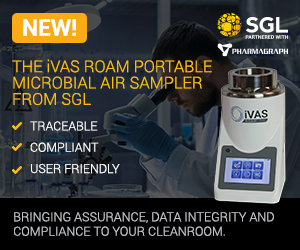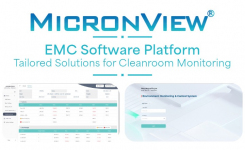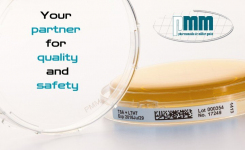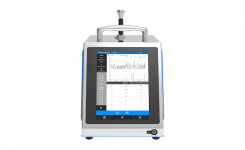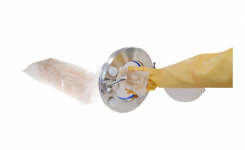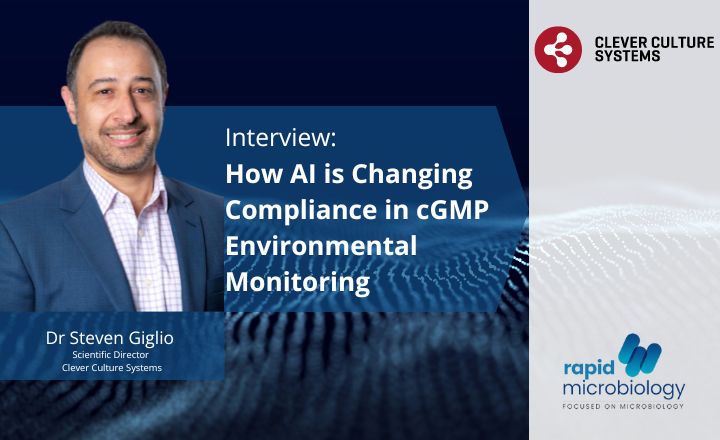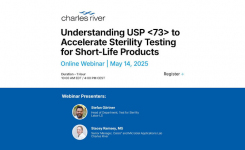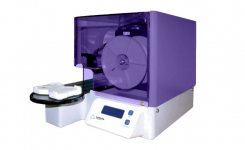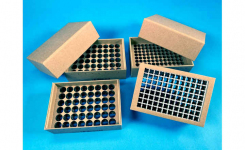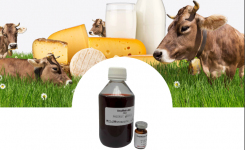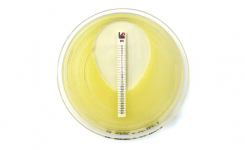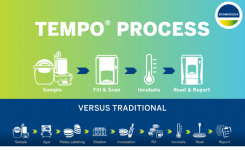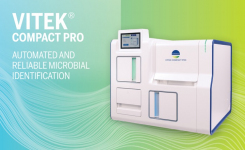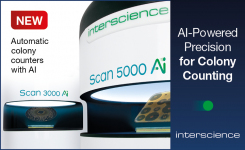
Key Points
- What's the difference between air sampling and air monitoring? - air sampling is like taking a 'snapshot' at that particular point in time whilst air monitoring if more like videoing what happens over a specified period of time.
- Active air sampling delivers a quantitative result
- Modern air samplers are portable, convenient and easy to use
- Operation can be semi-automated
- Potential for integration with environmental monitoring software for full data integrity
- Listen to our rapidmicrobiology podcasts on the effect of the new Annex 1 revision on microbial environmental monitoring: GMP Annex 1: Changes in Microbial Monitoring and Continuous Environmental Monitoring in New Annex I
Introduction to Microbiological Air Sampling
Ask a microbiologist to list the most important sources of contamination in any specific manufacturing operation and they will probably come up with people, raw materials and water as the top three. This is a perfectly reasonable response, but there is one other factor that is always present and that is air. Viable microorganisms can be found in the atmosphere almost anywhere – bacterial spores can be isolated from the jet stream several miles above the Earth’s surface – but the microbiology of the air is sometimes overlooked.
Airborne bacterial and fungal cells and spores may be present in droplets as bioaerosols, as very small individual particles that stay suspended for long periods, or as larger clumps and aggregates that settle rapidly onto surfaces. They can be an important source of infection in medical facilities and can contaminate sensitive manufacturing operations, but regular monitoring of airborne microorganisms is sometimes neglected.
Microbiological monitoring of the air in facilities where pharmaceuticals and medical devices are produced is essential and well established. In most countries it is a regulatory requirement, and international standards have been published for biocontamination control in cleanrooms and other controlled environments (ISO 14698-1/2). But airborne bacteria and fungi may be equally important in hospitals, in food factories and even in office buildings and other working environments. For example, high levels of airborne fungal spores in bakeries may have a significant negative effect on product shelf life, and airborne microorganisms may also be a contributory factor in episodes of so-called ‘sick building syndrome’. Monitoring airborne microorganisms is therefore a key component of environmental monitoring in many sectors and a range of technological solutions has been developed to help operators achieve an effective monitoring programme, not just in the pharmaceutical sector, but in hospitals, food factories and a variety of other environments.
Technology
There are two principal means of monitoring the microbiological population of air, passive monitoring and active sampling. Both have a part to play, but active sampling methods have become an essential environmental monitoring tool, especially in the pharmaceutical and medical device sectors.
Passive Monitoring
Passive monitoring is usually done using ‘settle plates’ – standard Petri dishes containing appropriate (usually non-selective) culture media that are opened and exposed for a given time and then incubated to allow visible colonies to develop and be counted. Settle plates are very limited in their application since they are only really capable of monitoring viable biological particles that sediment out of the air and settle onto a surface over the time of exposure. They will not detect smaller particles or droplets suspended in the air and they cannot sample specific volumes of air, so the results are not quantitative. They are also vulnerable to interference and contamination from non-airborne sources and the agar growth medium in the plates may deteriorate if they are exposed for too long. Settle plates may easily become overgrown in heavily contaminated conditions and interpretation of the data they produce can be difficult.
On the other hand, settle plates are inexpensive and easy use, requiring no special equipment. They are useful for qualitative analysis of airborne microorganisms and the data they produce may detect underlying trends in airborne contamination and provide early warning of problems. They are also useful for directly monitoring airborne contamination of specific surfaces. In an environment such as a low risk food factory, settle plates may provide an adequate means of monitoring biological air quality.
Active Air Sampling
Active air sampling requires the use of a microbiology air sampler to physically draw a known volume of air over, or through, a particle collection device and there are two main types.
1) Impingers - Impingers use a liquid medium for particle collection. Typically, sampled air is drawn by a suction pump through a narrow inlet tube into a small flask containing the collection medium. This accelerates the air towards the surface of the collection medium and the flow rate is determined by the diameter of the inlet tube. When the air hits the surface of the liquid, it changes direction abruptly and any suspended particles are impinged into the collection liquid. Once the sampling is complete the collection liquid can be cultured to enumerate viable microorganisms. Since the sample volume can be calculated using the flow rate and sampling time, the result is quantitative.
Impingers have disadvantages for routine microbiological monitoring of the air. Traditional designs are usually made of glass, which is undesirable in food and pharmaceutical production sites. Impingement into liquids may also damage some microbial cells and affect viability and overlong sampling times may allow some cells to multiply in the liquid collection medium. However, the liquid collection medium means that the sample can be analysed using a variety of methods, including molecular techniques such as PCR, so that results can be obtained more rapidly.
Instruments have been developed using variations on the impinger design, such as the Coriolis®μ sampler made by Bertin Technologies, and the SAS-PCR sampler from VWR-pbi, which are not constructed from glass and can be used to sample the air in clean rooms and other controlled environments. The Coriolis sampler uses a cyclone effect to accelerate the sampled air into the collection liquid. Any suspended particles in the air are thrown out by centrifugal force, collect on the walls of the conical collection vessel and concentrate in the collection liquid. The SAS-PCR device is designed specifically to collect pathogens for subsequent detection by molecular methods and circulates the collection liquid to prolong contact time with sampled air.
2) Impactors - Impactor samplers use a solid or adhesive medium, such as agar, for particle collection and are much more commonly used in commercial applications than impingers, largely because of their convenience. In a typical impactor sampler air is drawn into a sampling head by a pump or fan and accelerated, usually through a perforated plate (sieve samplers), or through a narrow slit (slit samplers). This produces laminar air flow onto the collection surface, often a standard agar plate or contact plate filled with a suitable agar medium. The velocity of the air is determined by the diameter of the holes in sieve samplers and the width of the slit in slit samplers. When the air hits the collection surface it makes a tangential change of direction and any suspended particles are thrown out by inertia, impacting onto the collection surface. When the correct volume of air has been passed through the sampling head, the agar plate can be removed and incubated directly without further treatment. After incubation, counting the number of visible colonies gives a direct quantitative estimate of the number of colony forming units in the sampled air.
Impaction samplers offer benefits in terms of convenience and pre-poured, gamma-irradiated contact plates and standard petri dishes from specialist suppliers can be used with them to minimise the risk of contamination and variation. They are also able to handle higher flow rates and the large sample volumes necessary to monitor air quality in clean rooms where the number of microbes present is likely to be very low. However, care must be taken not to allow agar plates to remain in the sampler heads for too long, or the medium may dry out and deteriorate. Microbial cells may also be damaged by mechanical stress during the sampling process and lose viability.
Most impaction samplers also do not allow the use of rapid methods to enumerate and characterise microorganisms, but rely on conventional culture for several days to obtain a result. This problem can be overcome to some extent by the use of a water-soluble polymer gel instead of agar. This allows the sample to be analysed by rapid techniques such as PCR or cytometry.
A wide variety of instruments have been developed using the impaction principle. One of the best known is the Andersen sampler, a multi-stage ‘cascade’ sieve sampler that uses perforated plates with progressively smaller holes at each stage, allowing particles to be separated according to size. Another well known instrument is the Casella slit sampler, in which the slit is positioned above a turntable on which is placed an agar plate. As air is drawn through the slit, the agar plate rotates, so that particles are deposited evenly over its surface.
Both of these instruments have been used for many years, but more recently a number of highly portable and convenient impaction samplers have been developed specifically for monitoring the air in production facilities and other sensitive areas. Most of these are sieve samplers, such as the Surface Air System (SAS) samplers made by VWR-pbi in Italy, and use agar contact plates or full-sized culture plates as the collection surface. However, some types, such as the RCS samplers from Merck Millipore, use a centrifugal impeller to accelerate air onto a dedicated agar-coated strip that can be incubated directly. These portable samplers can be hand-held, or mounted on a tripod during sampling, and can be programmed to sample a specific volume of air, or sequential samples at pre-set times. Samplers specifically designed to monitor the microbiological quality of compressed gases are also available.
Semi-automated systems, usually based on sieve type impaction samplers, are also available for monitoring clean rooms and controlled production areas. These systems typically use a number of sampler heads linked to a central control unit, which can be programmed to follow a pre-set sampling programme. The sampler heads can be fitted permanently in place so that they undergo the same sterilisation regime as the rest of the clean room. It is also possible to set up a wireless network of portable air samplers controlled by a central PC, with no need for any electrical or vacuum line connections. Semi-automated systems often allow integration with environmental monitoring and QC software packages, such as MODA-EM™ from Lonza, providing the basis of a paperless system for recording microbiological data.
Other types - Most commercially available microbiological air samplers use the impaction or impingement collection techniques, but other types of sampler are also used in some applications. The most commonly used alternative is filtration, where the air is drawn by a pump or vacuum line through a membrane filter. The filter medium may be polycarbonate or cellulose acetate, which can be incubated directly by transferring onto the surface of an agar medium, or gelatine, which can be dissolved and analysed by culture or rapid methods. Filtration methods are accurate and reliable and portable filtration samplers designed for the pharmaceutical industry are available. However, filtration is less convenient than impaction-based sampling and may cause dehydration stress in the trapped microorganisms.
Recently, instruments have been developed that are capable of detecting airborne microorganisms in real time. These employ laser technology to induce fluorescence in any viable particles in air drawn through the instrument and provide immediate detection and enumeration of microbial contaminants. An example is the BioLaz® instrument from Particle Measuring Systems, which is designed specifically for use in the pharmaceutical and medical products sectors. TSI's BioTrak® Real-Time Viable Particle Counter instrument uses similar Laser Induced Fluorescence (LSI) technology, but is also capable of simultaneous total and viable particle counts.
Air Sampler Validation and Calibration
Microbiological air sampling in clean rooms and other controlled environments usually requires the sampling of large volumes of air (at least 1 m3). It is also very important that samples are representative and the results of sampling accurate enough to ensure that the air meets regulatory standards, or guidelines. It is therefore essential that air samplers are properly validated and regularly calibrated to ensure accuracy. There are a number of points to consider.
- Physical efficiency of the sampler – the relative efficiency of the sampler in collecting particles over a range of sizes.
- Biological efficiency – the relative efficiency of the sampler in collection of microorganisms on a surface or in a liquid so that they are viable and can be counted.
- Validation of the instrument for its intended application and environment.
- The flow rate of the sampler – with large sample sizes, the flow rate of air through the sampling head is critical to the accuracy of the result.
Methods for estimating physical and biological efficiency are given in the ISO 14698-1 standard. Sampler manufacturers typically employ a third party laboratory to validate their instruments in this way, by challenging the instrument with particles and microorganisms in a controlled chamber. Physical efficiency is normally measured against membrane filtration sampling, while biological efficiency is compared with an established reference sampler such as the Casella slit sampler.
Validation for specific applications often requires operating a new sampling method in parallel with an existing system for a period sufficient to provide a valid comparison. Many sampler suppliers provide validation methods and recommendations for their instruments.
The flow rate of the sampler pump or fan should be properly calibrated and validated against a certified flow meter, preferably by a third party, at least once every twelve months and should also be regularly calibrated by the user to ensure that the sampler has not developed a fault or suffered any damage. Some sampler manufacturers offer a validation service and equipment, typically an anemometer, to calibrate samplers on site.
With the new revision to EU GMP Annex 1, there will be an increased focus on microbial air sampling with real-time air sampling devices.


